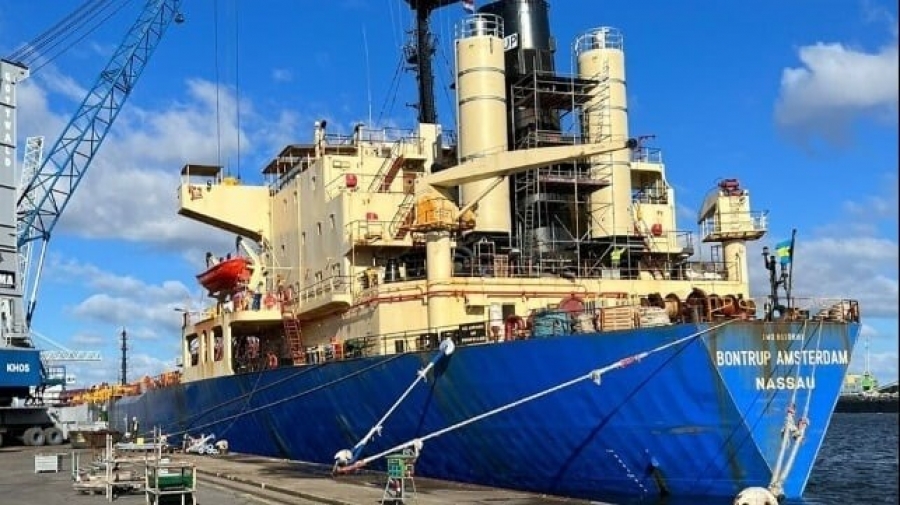Dry exhaust gas cleaning system installed on bulker Bontrup Amsterdam (SodaFlexx)
With traditional scrubber systems coming under increasing pressure for the wash residue which environmentalists highlight as a pollutant, a dry exhaust system sodium compound provides an alternative that can permit older, in-service ships to meet increasing emissions regulations. A dry system was recently installed on a Dutch-owned bulker with its manufacturer also highlighting the potential for a containerized system that further eases operations.
The Integrated Dry Exhaust Gas Cleaning System developed by UK-based SodaFlexx was recently installed on the Bontrup Amsterdam, a 39-year old dry bulker owned by the Dutch company Bontrup. Built in 1984, the vessel is 65,400 dwt and 736 feet long powered by a traditional heavy fuel propulsion plant. The installation of the dry exhaust system took place during the last week of February in Amsterdam. According to the companies the installation required less than three days with the vessel resuming service last week sailing from The Netherlands to the UK.
“The technical installation of the SodaFlexx System has been successfully completed and the commissioning is going to take place in March 2023. The project is running smoothly, although we had to make some adjustments right before the installation,” said Elwin Koning, Managing Director, Engineering at SodaFlexx. “The system offers a lot of flexibility and we have a wide range of options we can incorporate to achieve an optimized installation. This new SodaFlexx system uses our advanced Hyperion technology which uses AI to ensure optimal absorbent dosage for the required emissions zone.”
The SodaFlexx dry powder unit injects sodium bicarbonate powder directly into the exhaust gas stream to neutralize sulfur compounds (SOx). In the heat and turbulence of the exhaust gas stream, a chemical reaction occurs converting SOx to a highly stable and non-toxic salt. This salt is released safely into the atmosphere or can be captured by a cyclone particulate capture system and recycled ashore.
SodaFlexx highlights that the system allows vessels to burn HSFO (High Sulfur Fuel Oil). It can be connected to the main engine and also to auxiliary generators, boilers, and incinerators. The company offers an option for a prefabricated containerized and stackable units on a TEU footprint.
In addition to permitting the use of the lower-cost HFSO option versus Marine Gas Oil (MGO), the company also highlights that most older marine engines were designed to burn HFO. The dry exhaust system offers an option that is environmentally sensitive while permitting the ship’s owners to follow existing maintenance and lubrication protocols for their in-service ships.
“Finding the balance between economical and environmentally friendly solutions for the maritime industry is the ultimate goal of our business,” says Barry Bednar, CEO of SodaFlexx. “The transition to alternative fuels won’t happen overnight and we still have a global fleet to operate in the most sustainable way possible, and burning HSFO with our exhaust gas cleaning system has proven to be less CO2 intensive than using MGO or VLSFO on a “well to wake” basis.
The basis for the system, sodium bicarbonate, is produced by many manufacturers and on all continents. The company offers a containerized solution for the material aboard the ships or it can be delivered by truck or barge. The residue is also easy to recycle versus wash water from wet scrubbers which is increasingly being regulated.




















